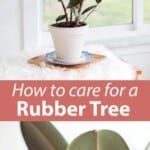Is there a perfect houseplant? Something easy to care for, can grow for years and has a timeless beauty? I think the rubber tree ticks all of those boxes. This tree has glossy, thick leaves and makes quite an impression in any room.
My favorite rubber tree is in a scene from the movie Sabrina with Audrey Hepburn. In the scene, they are having a lavish party and there is a beautiful, tall rubber tree in the room. That rubber tree is definitely a plant goal for me.
Maybe someday mine will get that big and beautiful! With proper care, the tree can reach up to 10 feet tall (sometimes taller) indoors!
Related: Love plants? Learn to care for Fiddle Leaf Figs, Pilea Plants, Snake Plants, Monstera, and Air Plants.

The rubber tree is also known as the Ficus Elastica and comes from India and parts of tropical Asia. The shiny, leathery leaves give this plant a distinct look. There is really nothing like it! The rubber tree has a wonderful shape and is a great option for anyone who loves houseplants.

Potting
When you bring home a new rubber tree, here are a few things to consider in regards to potting it. It might seem like a good idea to put your plant in a big pot so it has lots of room to grow, but the rubber tree prefers to be a bit crowded in a pot.
Try to choose a pot that gives about 2 inches of soil around the whole diameter. This will give your plant plenty of room to grow and thrive. When choosing a pot, earthenware is always a great option. Unglazed earthenware allows the moisture in the dirt to evaporate out of the pot and dry out faster.
A glazed earthenware pot will not have the same abilities to let the moisture come out. I use both kinds of pots but a really important aspect of the pot is to make sure it has a drainage hole so water has a way to escape (sitting water will most definitely kill your rubber tree).
Once you have your pot figured out, it’s time to think about soil. The rubber tree likes well draining soil. An all-purpose indoor mix works great, but I add some extra perlite to give the soil more aeration.
Perlite is an organic material that comes from volcanic eruptions and you can find it at most garden stores. Scoop some of your potting mix and place it on the bottom of the pot. Then, put your plant in so that it sits about 3 inches under the top pot.
Fill in the rest of the dirt, making sure your plant stays nice and straight. Use your hand to move dirt down as you move around the pot. Once the sides are filled, place a small layer of dirt over the top of your plant.
Once the plant is potted, place it in the spot you intend to leave it (rubber trees don’t like change). Repotting can sometimes make your plant drop leaves, so if this happens, don’t fret … it’s just getting used to its new environment.
A period of rest is vital for your rubber tree once it’s been repotted and placed in a new spot. Not sure about the best spot to put your plant?
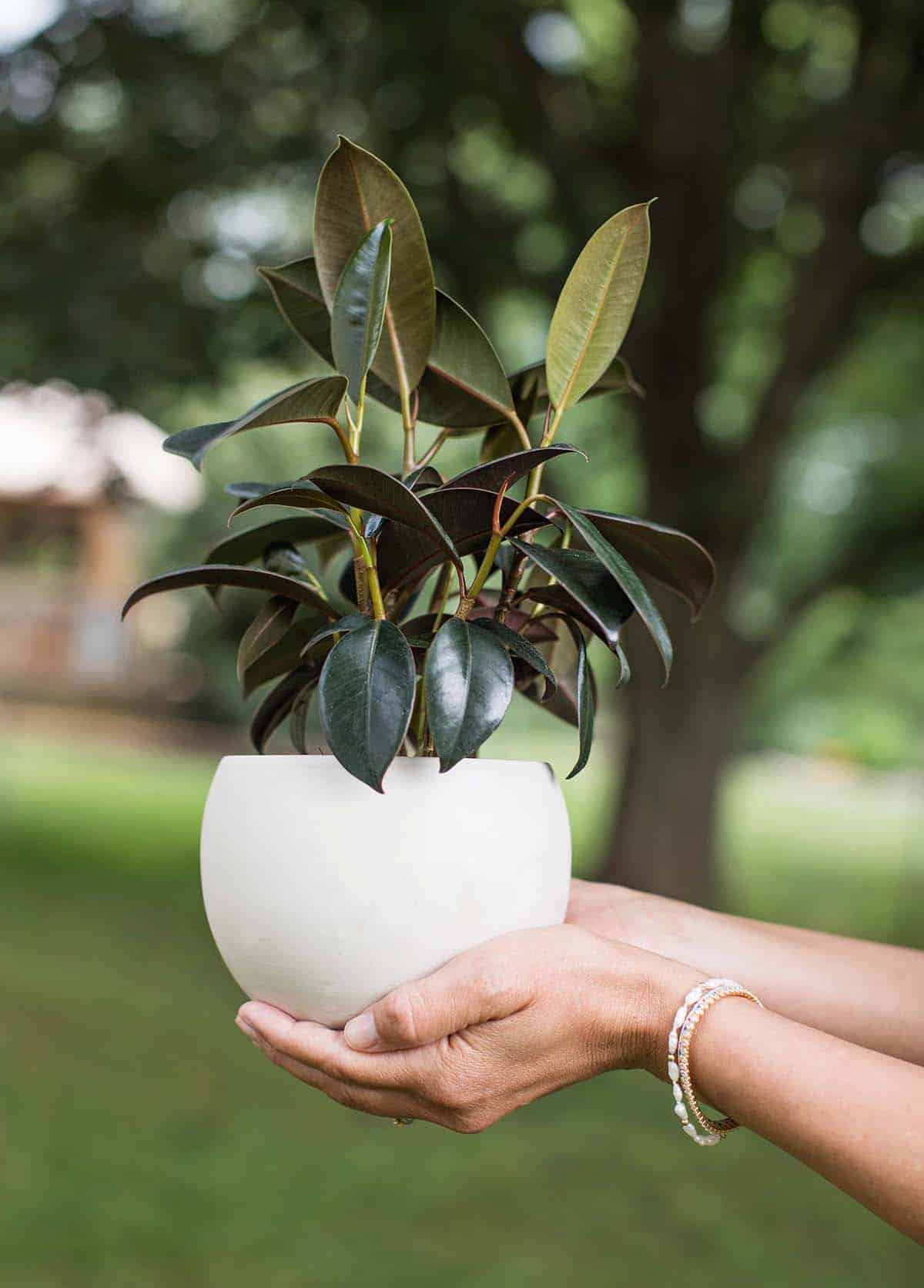
Light
This plant loves to drink up the light, so placement in your home is crucial to maintain a healthy plant. The first thing when choosing a spot is to make sure that it doesn’t have a draft, isn’t near a vent, or has an AC unit blowing on it.
The plant will most likely drop leaves (or it can die) if it is near a draft. The rubber trees thrive on an indoor temperature of 60-70 degrees Fahrenheit. Find a place in your home with medium to bright light. Brighter light will help your plant grow faster.
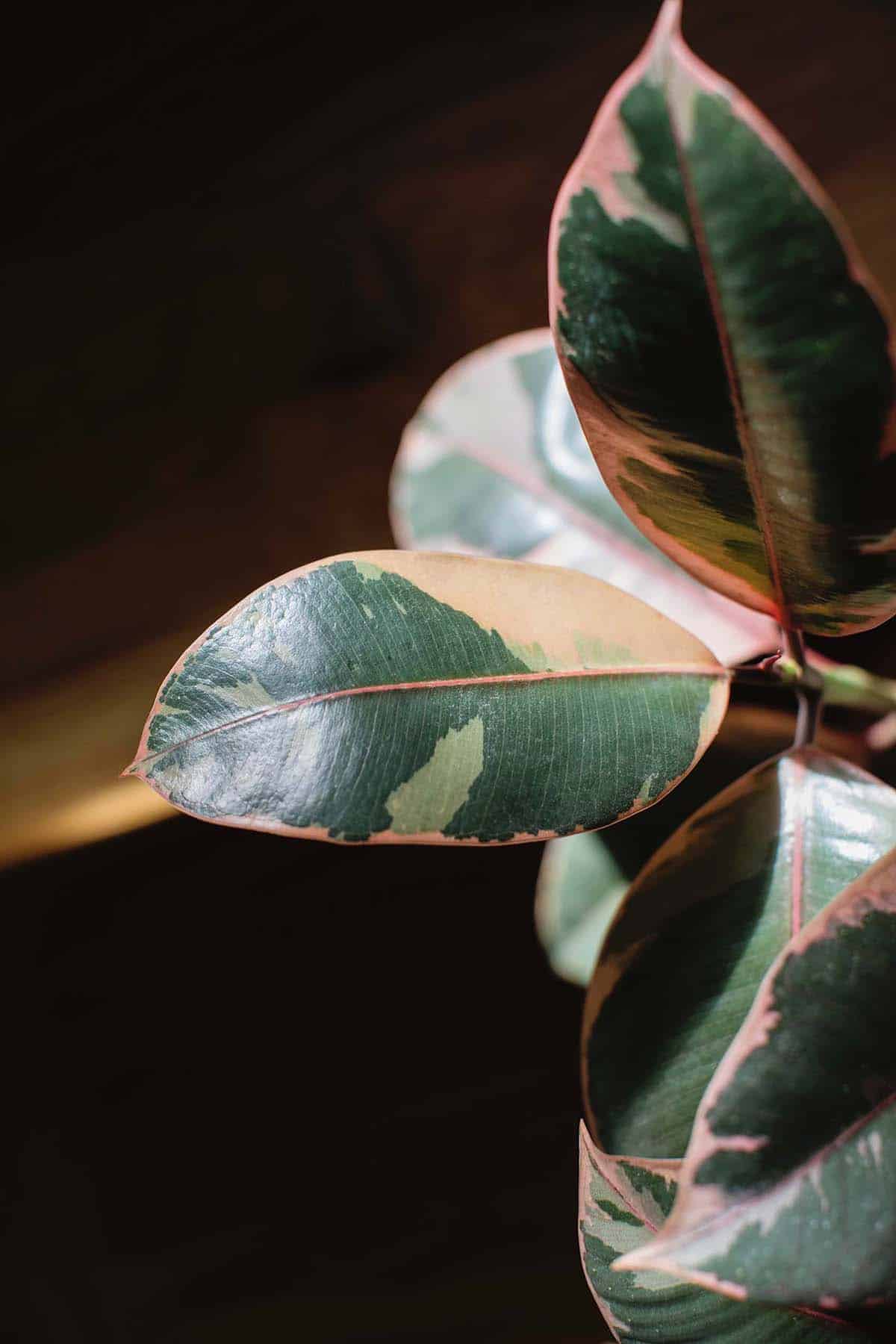
If you put it in a darker spot of a room it can become “leggy” as it tries to stretch toward the light. If your plant is “reaching” then just place it in a brighter spot. The rubber tree has some beautiful variegated species that do require more light.
The tricolor variegated species has green, white and pink in its leaves. The white in the leaf requires more light due to lack of chlorophyll levels. They can “burn” easily so keep an eye on the leaves.
They will tell you if they are getting too much light. If there is any brown on the tip (burning), that means there is too much light hitting your variegated plant.

Back to the non-variegated rubber tree. What if you don’t have great window light or you’re worried about your room being too dark? Placing a mirror by the plant will help bounce more light onto your plant.
Another tip to create a brighter environment is a white room. White paint will bounce more light around! Seems so simple, but it really is effective in helping with a low light situation in a room.
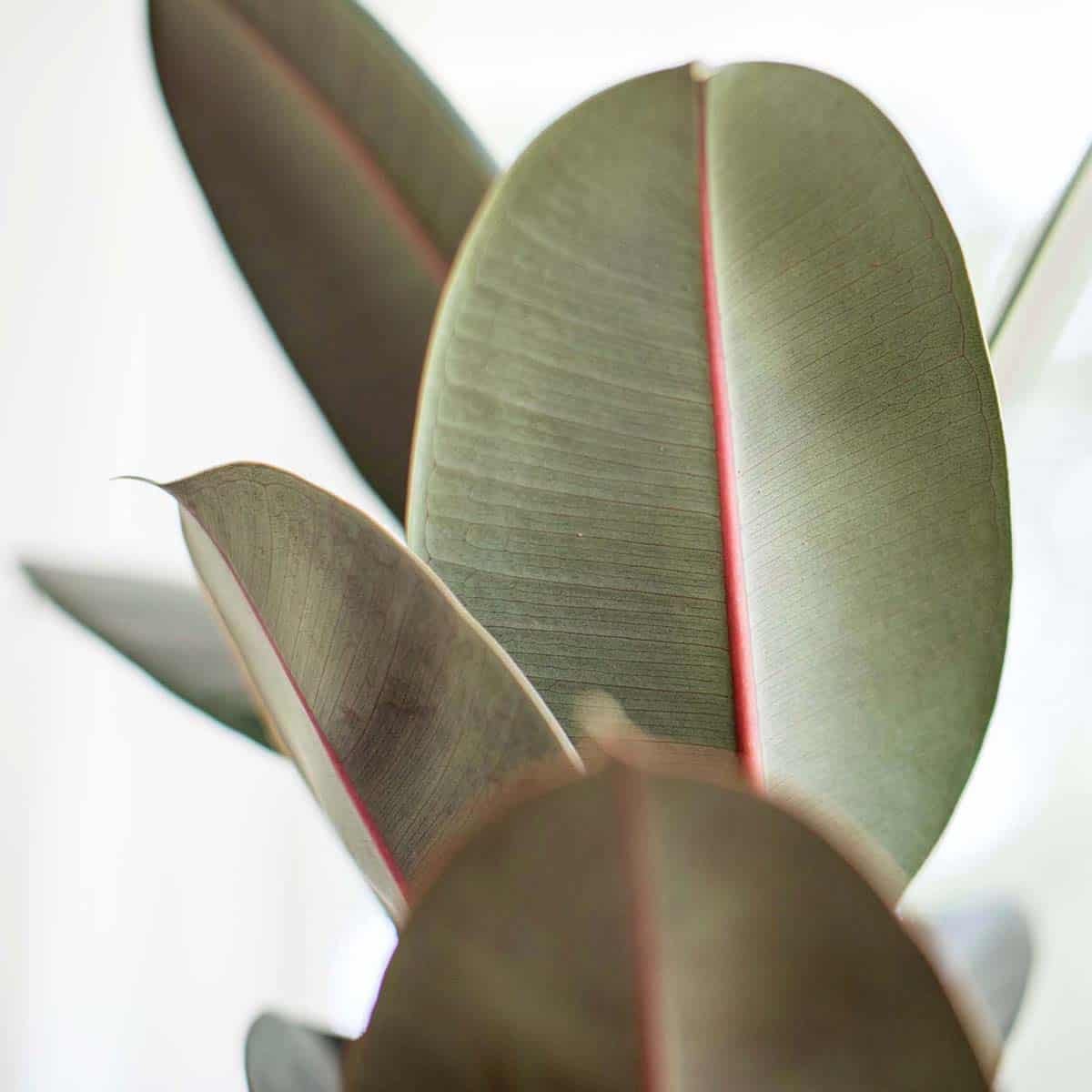
If you want to get maximum light on your rubber tree, then make sure the leaves are free of dust. I have found that the rubber tree can get quite dusty, so check the leaves every few weeks for dust buildup.
If there is dust present, then a damp cloth will work great to remove it. When dusting the rubber tree, be careful with new leaves. The new, thin leaves are very fragile and if damaged while they are young, then the damage will stay on the leaf its whole life.
When dusting mature leaves, make sure you place your hand under the leaf for support. Extra pressure on the leaf could cause it to snap while dusting. This has happened to me before and it’s quite sad.
When it snaps, there will be a white sap-like liquid that comes from the leaf where it was detached from the branch. It is completely normal but it can irritate some people’s skin, so wash hands just in case it gets on your skin.
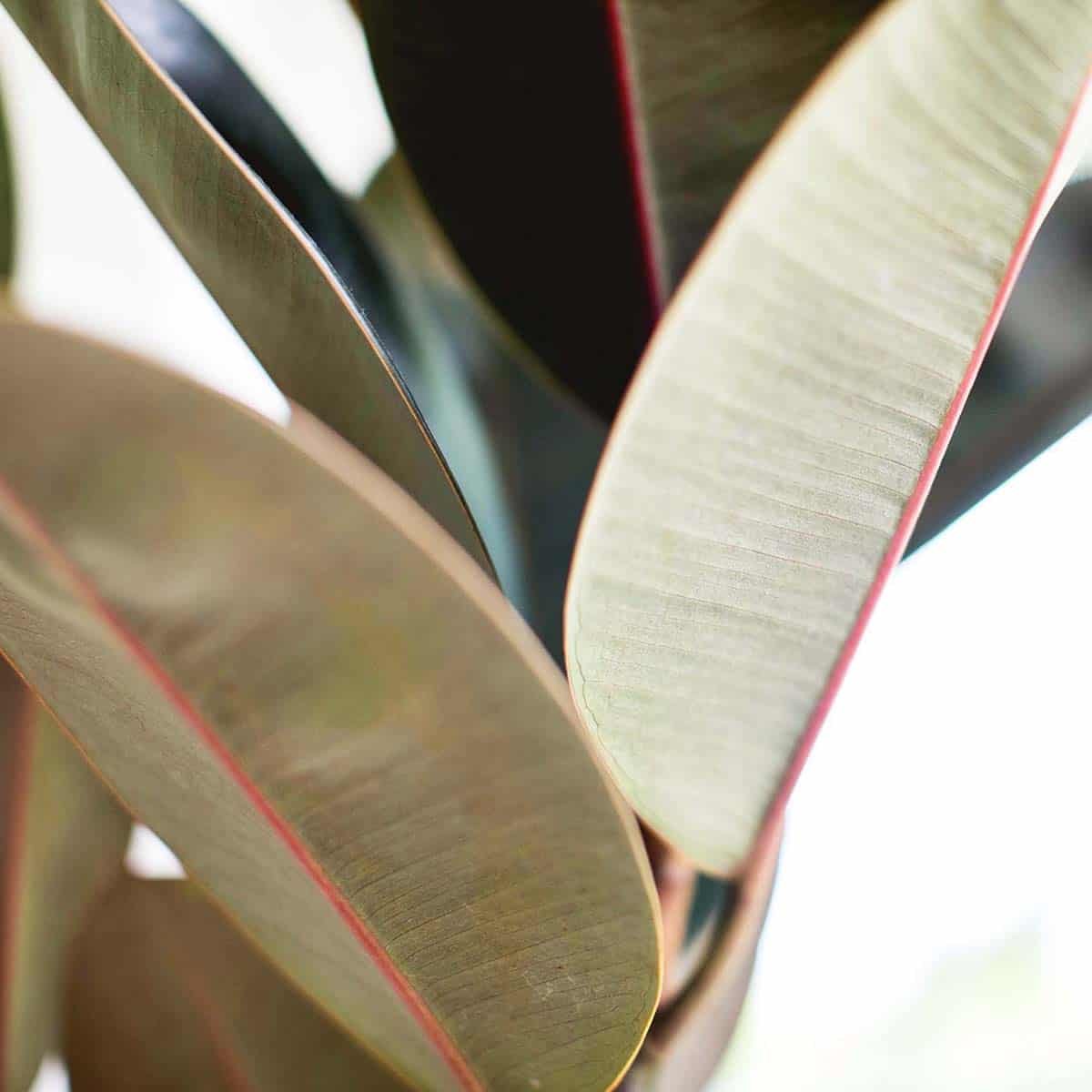
Watering
Finding a consistent watering rhythm for your tree will help give you the confidence you need to keep your plant alive and healthy for years to come. If the leaves start to droop a bit, then you know your plant is very thirsty.
Rubber trees like to dry out but they don’t like to become bone dry. Another way to tell if your plant is really thirsty is when you’re watering and the water runs out quickly through the soil. Soil with more moisture will take longer to drain. If the water runs straight through, then give it another good soak.
The rubber tree enjoys generous watering but make sure it has time to dry out to avoid root rot (this happens when the plant is waterlogged or if it sits in water too long).
If root rot happens. then your plant doesn’t have a great chance of living anymore, so avoid overwatering at all costs. As a rule of thumb, let the top 2/3 of your plant’s soil dry out before watering your rubber tree again.
You can also stick your finger in the soil 3-4 inches) and feel if there is any moisture or pick up the pot and feel if the post is heavy from holding moisture. After watering your rubber tree, if any water drains into your saucer, discard the extra water so the plant doesn’t sit in water and get root rot.
Watering duration will depend on your climate and humidity levels. If you live in a drier climate, then your plant will need to be watered more frequently. Once you figure out your plant’s rhythm/duration of drying out, a watering routine should be really easy to adhere to. This plant loves consistency and will grow better with a steady routine.

Pruning
The rubber tree can grow tall if left unpruned. If left unpruned, your tree will have one long trunk. If this is your desired look, then great! This will make your tree grow vertical faster!
If you’d like to have more of a “bushy” tree, then you can use your fingers and pinch off a new growing tip to promote the plant to create more branches.
If you snip or prune a branch, then that part will split into two branches once the new growth comes in. Pruning is an exciting habit that produces great results over time.
Fertilizing
The rubber tree loves to be fed with fertilizer to promote growth. Fertilize your tree in the spring/summer (the growing season), but back off in the fall/winter months. Fertilizing your plant every other watering session is a good rule of thumb.
I love using a liquid fertilizer that I can add to my water.

Knowing my fertilizer is a liquid gives me the peace of mind that the fertilizer is evenly distributed throughout the water (unlike granules or a powder mix). When choosing fertilizer, it will have three letters on the package: NPK.
The “N” stands for Nitrogen. Nitrogen helps with chlorophyll production, which leads to photosynthesis, which leads to a bigger, healthier plant! The “P” stands for Phosphorus. Phosphorus helps with keeping the roots of your plant healthy and promotes root growth.
The last letter “K” stands for Potassium. Potassium helps your plant distribute nutrients. It also helps your plant fight off disease. Think of it as an immunity booster for your plant! A standard fertilizer for houseplants will work great for your rubber tree.
Make sure to read the label of your fertilizer and follow the instructions. I like using half of the recommended fertilizer amount with the rubber tree. Using too much fertilizer can cause your plant to burn.
Burning means that too many nutrients have been stored in the root system and they cannot accept/absorb water anymore. If there is a chance that your plant has had too much fertilizer then give it a good watering to flush the roots. Don’t fertilize the next week so that your plant has time to recover and rest.
What if Your Rubber Tree is Dropping Leaves?
When you repot your rubber tree or move it, it is very common for it to drop a couple of leaves due to shock. Old leaves will fall off here and there as they age out as well. This is totally normal!
What if your rubber tree drops a bunch of leaves at the same time? This isn’t normal and it could be due to overwatering or other issues. If your tree’s leaves begin to droop, turn yellow and eventually fall off, then this is most likely due to overwatering.
The yellowing of the leaves is called Chlorosis. Chlorosis means that chlorophyll is not forming in your plant. It is amazing that plants can tell you what they need through their color.
If your leaf is turning yellow, it is likely a call for help. Back off watering and make sure your plant is drying out between watering so that it doesn’t get waterlogged.
If it continues to happen, pop your plant out of the pot and check for root rot. The quickest way to tell if your plant has succumbed to root rot is finding mushy, black or dark roots. If you see this, sometimes your plant can be saved but there is a chance the roots are done and the plant won’t make it.
If you can, snip the dead roots out of the root system and place the plant in a pot of fresh soil (not the waterlogged soil from the previous pot). Give your plant some time and hopefully it will come back to life!
Another reason your plant’s leaves could be turning yellow is a lack of light. If this is the case, then set your plant in a brighter spot so it can soak up more sun. The sun is like medicine for your plant and this could cure your leaf drop problem. Also, make sure the plant is not near a draft as this will also cause the leaves to drop.
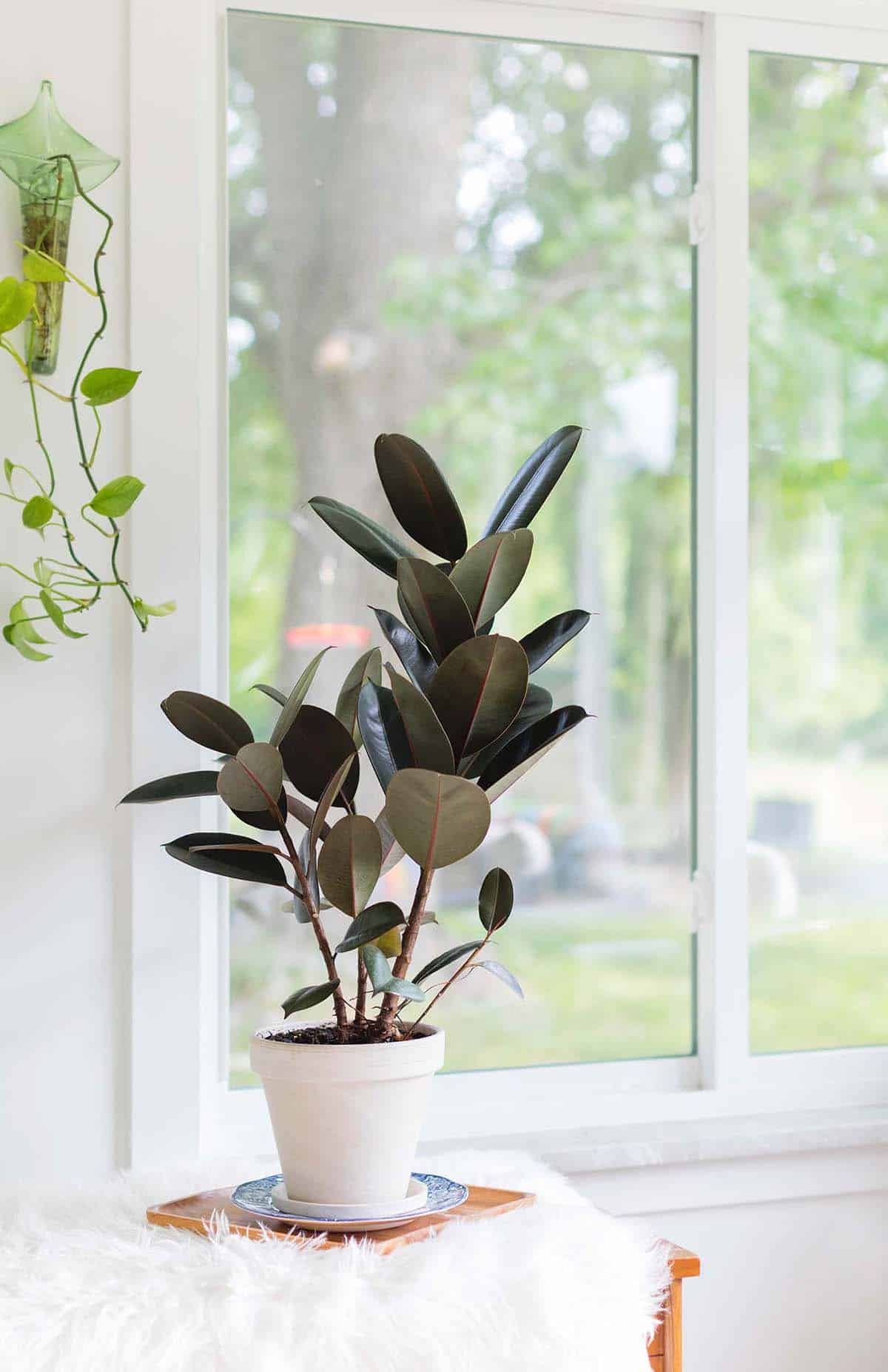
The rubber tree’s temperament is pretty easygoing and it is a great addition to any plant lover’s home. I hope these tips help and you’re able to enjoy your rubber tree for years to come! -Janae

